Country Louisiana

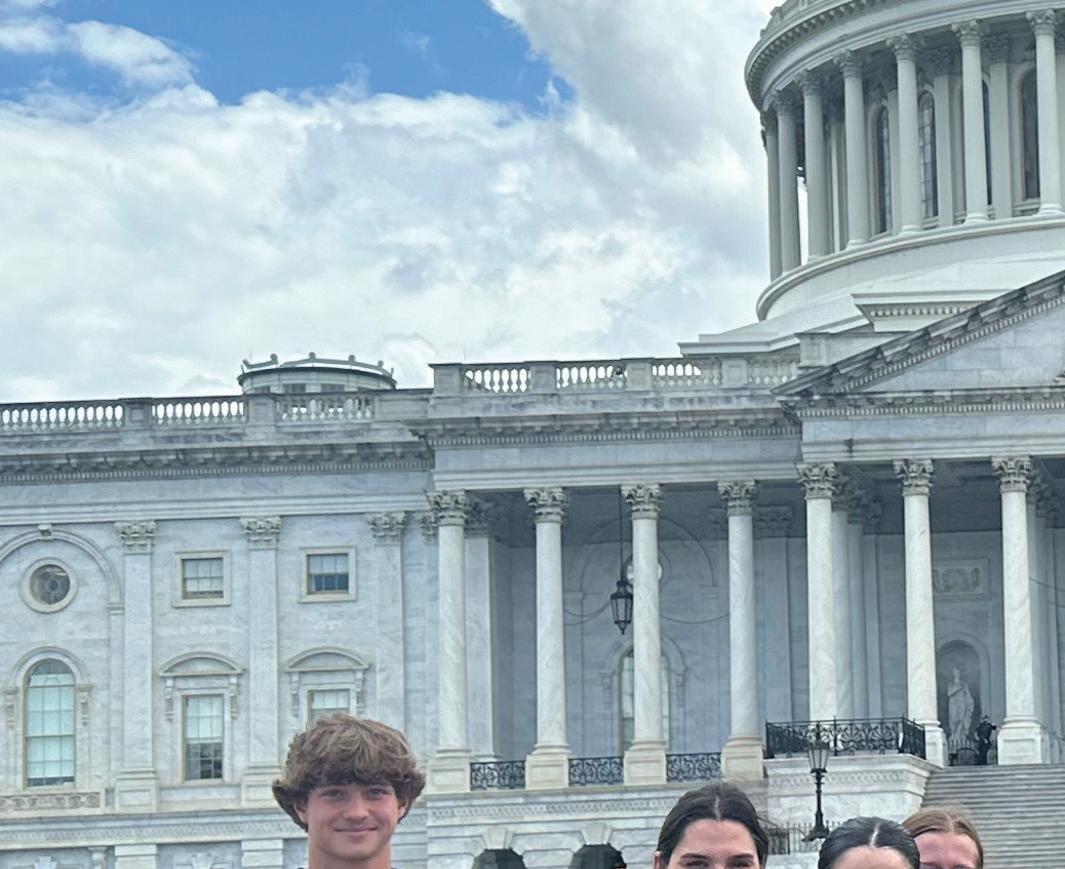
























Students gain knowledge, appreciation and friendships during Youth Tour Page 12


































An exploration of 15 ports of call, with guided excursion options at each
All onboard meals and our signature evening cocktail hour
Full enrichment package with guest speakers and nightly entertainment
All tips and gratuities

Immerse yourself in the sights, sounds, and tastes of New England. From quaint island villages to the breathtaking beauty of the coastline, summer in New England is a truly delightful experience. Discover the region’s rich maritime heritage, savor a traditional Lobsterbake, and marvel at grand mansions of the Gilded Age. Return to the comfort of your onboard sanctuary and bask in the warm camaraderie of fellow guests and crew.
There’s a song that says, “Just a small-town girl, living in a lonely world.” And in many ways, that’s how I felt growing up in my small Louisiana town. But what I’ve learned is that even a small-town girl can dream big and find herself in places she never imagined— like Washington, D.C.
My name is Lylah Crain, and I am from Pine, Louisiana. It’s the kind of place where everyone knows your name, and on the rare chance you ever pass through, if you blink, you might just miss it.
In my little town, opportunities don’t exactly line the streets. You have to look a little harder and dream a little bigger. When opportunities like going on Youth Tour present themselves, you have to run full speed at them.
When I got the call telling me I had been chosen for Youth Tour, I was ecstatic. But I had no idea just how much this experience would open my eyes and change the way I feel about myself and my future.
It’s easy to feel small in a place like Washington, D.C. It’s a big city full of rich history and important people. But as the days went on, I came to learn that even someone from the smallest place can belong in the biggest room.
On Youth Tour, we spent a whole day on Capitol Hill.
I’ll never forget seeing that beautiful building for the first time. It was on those steps that my fellow Louisiana delegates and I got to meet Sen. Bill Cassidy. I asked him, “What is your favorite part of your job?” and he looked me in the eye and said, “Meeting people just like you.” His words inspired me and reminded me why leadership is about connection and impact.
That sense of connection stayed with me as we later met interns from Louisiana working on Capitol Hill. Hearing their stories made it clear that this isn’t just a distant dream—it’s truly possible. Their experiences encouraged me to think bigger about my own future and
imagine how I might serve and represent others one day. These experiences made me reflect on what kind of leader I truly want to be. And my thoughts led me straight back home—to my small town, where those values first took root. It’s where I learned the importance of community, the value of hard work, and the power of personal relationships. In a small town like mine, you grow up understanding that showing up for others matters, that dreams require grit, and that how you treat people will follow you wherever you go. But more than anything, you learn that real success isn’t measured by where you stand— it’s measured by who you bring with you.
Now, as the new Louisiana Youth Leadership Council Representative, I realize that I represent so much more. I don’t just represent my small town, but every small town in Louisiana and every person who has ever felt small in this big world.
COMMUNICATIONS COORDINATOR Conley Bourgeois
ACCOUNTING MANAGER Beth Fraser
Board of Directors
President Michael Heinen
Vice President Roger Dale DeHart
Secretary/Treasurer Richard Sitman



ALEC
BEAUREGARD ELECTRIC COOPERATIVE INC.
Mike Viator Tommy Cryar
CLAIBORNE ELECTRIC COOPERATIVE INC.
Mike Marcotte Lane Davidson DEMCO
Daniel Berthelot Richard “Dickie” Sitman
JEFF DAVIS ELECTRIC COOPERATIVE INC.
Michael Heinen Byron Hardee
Trevor Benoit Roger Dale DeHart WASHINGTONST. TAMMANY ELECTRIC
INC. Joe Jarrell Dennis Glass
Associate Member


I would like to thank all of you for this amazing opportunity. Thank you for giving me the honor of representing our state. I would especially like to thank my co-op, Washington-St. Tammany Electric, for sponsoring me on the trip of a lifetime. I hope to use what I’ve learned to encourage other young people from small towns to dream big, step forward and believe they belong anywhere they choose to go.
And I would remind them of the words of the hit band Journey: “Don’t stop believin’.”
Thank you.

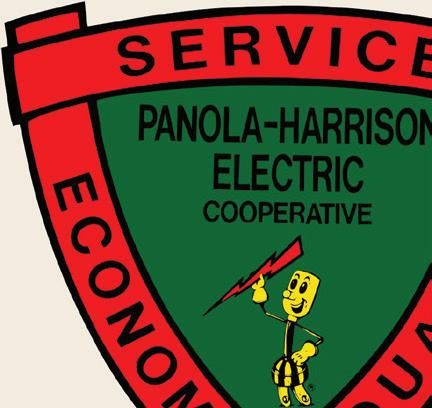

PANOLAHARRISON ELECTRIC COOPERATIVE
410 E. Houston St. • P.O. Box 1058
Marshall, TX 75671

903-935-7936 local • 800-972-1093 toll-free Website: phec.us
OFFICE HOURS
Monday through Friday, 8 a.m. to 5 p.m. 24-hour service for outages and emergencies
GENERAL MANAGER
Austin Haynes
BOARD OF DIRECTORS
District 1: Paul Fortune | Treasurer
District 2: Albert Tiller | President
District 3: Jay Goswick | Vice President
District 4: Brad Richardson
District 5: Debbie Burch
District 6: Roger Connell
District 7: Gene Stough
Year organized: 1937 Counties and parishes served: Harrison, Panola, Caddo and DeSoto
Connected meters: 20,648
Members: 13,722
Energized line: 2,465 miles distribution; 72 miles transmission
Panola-Harrison Electric Cooperative is an equal opportunity provider and employer. If you wish to file a civil rights program complaint of discrimination, complete the USDA Program Discrimination complaint form online at ascr.usda. gov/complaint_ filing_cust.html or at any USDA office, or call 866-632-9992 to request the form. You may also write a letter containing all of the information requested in the form. Send your completed complaint form or letter by mail to U.S. Department of Agriculture, Director, Office of Adjudication, 1400 Independence Ave. SW, Washington, D.C., 20250-9410, by fax to 202-690-7442 or by email to program.intake@usda.gov.
Louisiana Country (USPS 473-180) is published bimonthly by the Association of Louisiana Electric Co-ops Inc., 10725 Airline Highway, Baton Rouge, LA 70816, in partnership with Pioneer Utility Resources.
Annual subscriptions: Members $2.59. Nonmembers $5.
Postmaster: Send form 3579 to 10725 Airline Highway, Baton Rouge, LA 70816.
Periodicals postage paid at Baton Rouge, Louisiana 70821, and additional mailing offices.
Every October, we celebrate National Cooperative Month. Why? Because it’s a time to reflect on what makes co-ops special. This year, we’re adding a little extra flavor with our slogan, letting you know as a cooperative, members are our jam. It might sound like a silly slogan we’re using to spread the fun, but it’s the truth. Cooperatives put people before profits, serve the community and give you and your neighbors the power to make local decisions. To me, that’s as sweet as it gets. Just like your favorite jam, PanolaHarrison Electric Cooperative is made of real ingredients. Real people. Real care. Real principles. Seven principles, to be exact, which guide everything we do, and remind us why the cooperative model is worth preserving.
Our Recipe for Success:
The Seven Cooperative Principles
1. Open and Voluntary Membership
Everyone is welcome. It doesn’t matter your race, religion or gender. If you need our services and accept the responsibilities of membership, you’re a member.
2. Democratic Member Control
You’re not a customer, you’re a member. That means you help guide the direction of your cooperative by electing fellow members to serve on our board of directors and make decisions on your behalf.
3. Members’ Economic Participation
When you invest in us, we invest in you. At PHEC, we spread your dollars across the community, improving your service, strengthening local nonprofits and, when possible, returning any leftover money to you.
4. Autonomy and Independence
We’re local through and through, which means we answer to you, not faraway investors. It also means we won’t enter into any agreements or partnerships that put local control of the co-op at risk.

5. Education, Training and Information
Knowledge is power. We prioritize education, training and sharing information about the issues that affect our co-op.
6. Cooperation Among Cooperatives
Have you tried a mixed-berry jam? The flavors support each other just like co-ops support each other. Together we’re stronger. We work with other cooperatives at the local, state and national levels to share knowledge, improve services and strengthen the communities we serve.
7. Concern for Community
This is our home, too, and PHEC succeeds when our communities do. That’s why we care deeply about supporting you, through annual scholarships for East Texas Rural Electric Youth Seminar students and donations to local organizations.
These aren’t just words on paper, they’re the ingredients that make PanolaHarrison Electric Cooperative a sweet addition to our community. Members are our jam all year long.
Thanks for being part of something meaningful.
100% TRANSPARENT
Co-ops build trust among members with open communication about finances, operations and leadership actions.
SWEETENED WITH COMMUNITY LOVE
Co-ops are dedicated to giving back to the community and strengthening the local economy.
100% LOCALLY OWNED
Co-op members make decisions that benefit the community, not far-o investors.
EVERY BERRY’S VOICE
Everyone is welcome to join a co-op, and everyone’s voice matters equally.
Spread the sweetness and preserve the future by learning about your co-op at phec.us.
0% PROFITS PRESERVED
Profits are reinvested or shared among members, not siphoned by corporations.
SUSTAINABLY & ETHICALLY SOURCED
Co-ops are strong, resilient, accessible and fair thanks to shared ownership and shared values.
SERVING SIZE: 1 MEMBER=1 VOTE
Co-ops are democratic, with each member getting one vote, ensuring equal say in decision-making.




















The Louisiana Member Services Association and the Association of Louisiana Electric Cooperatives recognized cooperative employees and their families for outstanding volunteer service at this year’s annual meeting. In a unanimous and heartfelt decision, LMSA members voted to permanently rename the volunteer awards as the Kevin Reeves Cooperative Spirit Awards—a tribute to a beloved Beauregard Electric Cooperative employee whose life and work embodied selfless service.
Kevin spent 33 years at Beauregard Electric. He was a friend to many in the cooperative family and a steady presence in his church and community. His unexpected death in June 2023 left a void, but his impact endures—made visible now each year in the award that bears his name.
This year’s Kevin Reeves Cooperative Spirit Award winner is Frank Fowler of DEMCO. Frank has spent nearly two decades pouring time and talent into the Good Samaritan Youth Camp—organizing activities, serving on the leadership board, recognizing standout campers, cooking, cleaning, fundraising and playing drums during worship services. His commitment to service reflects the spirit these awards are meant to celebrate. Washington–St. Tammany Electric Cooperative was also recognized with a Kevin Reeves Cooperative Spirit Award for its



Frank Fowler, DEMCO—Spent nearly 20 years serving the Good Samaritan Youth Camp through programming, leadership, awards, cooking, cleanup, fundraising and music ministry.
Ty Harrington, Beauregard Electric Cooperative— Organized a St. Jude Children’s Research Hospital “Push-Up Challenge,” recruited fellow lineworkers and launched a GoFundMe campaign that drew community support and raised more than $1,000.
William Howell, Washington–St. Tammany Electric Cooperative—Director of the free “Liars and Lunkers” kids fishing tournament, first organized by his family more than two decades ago; secures sponsors and participants to





ALEC recognizes training milestones, RESAP completions and lost-time-free records
At the 2025 Association of Louisiana Electric Cooperatives Awards and Safety Banquet in July, cooperatives and individuals were honored for yearlong accomplishments in safety and training. ALEC’s safety program—one of the most relied-upon services it offers—equips employees who work in dangerous environments to do the job right and return home safely.
ALEC member cooperatives participate in the Rural Electric Safety Achievement Program—a rigorous, third-party review conducted every three years by certified loss-control professionals. The team evaluates facilities, equipment and day-to-day procedures with one goal: continuous improvement.
This year, Jeff Davis Electric Cooperative and South Louisiana Electric Cooperative Association completed the RESAP inspection and each received a flag to display at their headquarters.
ALEC commends all member cooperatives for their achievements and continued commitment to safety.

Bobby Brown, Beauregard Electric Cooperative’s vice president of operations accepted the Traveling Statewide Safety Award on behalf of BECi. The winner is determined by a formula that weighs employee incidents, incident severity, total man-hours and vehicle accidents.
ALEC recognized member systems that worked without a lost-time accident:
• South Louisiana Electric Cooperative Association—More than 4,715,603 work hours since December 1996
• Beauregard Electric Cooperative—More than 555,979 work hours since November 2022
• Claiborne Electric Cooperative—More than 827,780 work hours since June 2024
• Washington–St. Tammany Electric Cooperative More than 249,132 work hours since April 2024
(A lost-time accident is an incident that results in an employee missing work beyond the day of injury.)

By Miranda Boutelle
Q: What are some ways I can improve the efficiency of my refrigerator and freezer?
A: When exploring ways to be more efficient with refrigerators and freezers, we often find ourselves stuck between convenience and conserving energy. While you can upgrade to newer equipment, care and equipment habits can be just as important to saving energy.
The U.S. Department of Energy explains what to look for in existing equipment and new appliances. In general, the larger the refrigerator, the more energy it uses. The most efficient models are typically 16 to 20 cubic feet. Models with the freezer on top tend to use less energy than bottom freezers or side-by-side units. A refrigerator 15 years or older uses about 35% more energy than an Energy Star-certified model.
Let’s explore some tips to keep your refrigerator running efficiently.
Keep it organized. One of the biggest issues with refrigerator energy use is keeping the door open. An organized fridge makes food items easier to find, minimizing open-door time and keeping cold air inside. Place items in the same spots so they are easier and faster to find. I tell my children to take a quick look inside at the options and close the door while they are deciding what to eat.
Keep it clean. Regularly cleaning the gasket—a flexible strip around the perimeter of the fridge door—ensures a tight seal between the door and the unit to keep cold air inside. If the gasket does not seal tightly, it should be replaced.
Removing and cleaning the vent at the bottom of the unit can help airflow. For the coils at the back, use an extended cleaning brush instead of moving the fridge and risking injury.
Keep food safety in mind. The Department of Energy recommends setting the refrigerator temperature between 35 and 38 degrees and the freezer at zero degrees.
If you have a second refrigerator or freezer, here are some things that can help you save energy.
Do you need it plugged in year-round? Perhaps you can keep it empty and unplugged for part of the year. Maybe you only really need it during the holiday season. Unplugging it for the months you aren’t using it saves energy, and you still have it as a backup when you need it.
Empty it before restocking. If you are a hunter or buy meat in bulk, this allows you to avoid food waste and unplug the extra appliance when it is not needed.
If possible, consider the location. Keeping the second fridge or freezer in a cool basement versus a hot garage requires less energy.
Embracing simple cleaning and food storage habits can help you be more efficient with your in-home refrigeration.



Purvis, MS - If you experience numbness or tingling in your hands, arms, legs, or feet or if you experience shooting or burning pain, this is important.
Please read this carefully.

Peripheral Neuropathy is when small blood vessels in the hands, arms, feet or legs become diseased and tiny nerves that keep the cells and muscles working properly shrivel up and die.
Early-warning symptoms include tingling and numbness, mild loss of feeling in your hands, arms, legs or feet, inability to feel your feet, which increases your risk of foot-injury and falling.
More Advanced Symptoms Include...
Loss of coordination & dexterity, which puts you at increased risk of accidents.
Inability to feel clothing like socks and gloves.
High risk of falling, which makes walking dangerous, and makes you more dependent on others.
Burning sensations in your arms, legs, hands or feet that may start mild, but as nerves and muscles die, may feel like you're being burned by a blow torch.
Ignore the early warning signals long enough and you risk progressive nerve damage leading to muscle wasting, severe pain, loss of balance and a lot of staying at home wishing you didn't hurt.
When every step is like walking on hot coals, sitting still may be the only thing you feel like doing. But there's little joy in sitting still all day long.

Now here's the scary part....
Nerve damage CAUSES cell damage.
Cell damage SPEEDS UP nerve degeneration
Without treatment this can become a DOWN-WARD SPIRAL that accelerates.
The damage can get worse fast. Mild symptoms intensify. Slight tingling, numbness or lack of feeling can turn into burning pain.
Before you know it, damage can become so bad you hurt all the time.
Unless this downward spiral is stopped and nerves return to proper function - the damage to nerves and cells in the affected area can get so bad your muscles begin to die right along with the nerves and cells. And that sets the stage for weakness, loss of mobility, disability, and dependence on others.
If you have early warning signs of peripheral neuropathy, (tingling &/or numbness, loss of feeling or pain) it's CRITICAL you get proper treatment. It's critical, because with proper treatment the symptoms can often be reversed. Without it, you are playing Russian Roulette with your health.
Once your nerve loss reaches 85%, odds are there's nothing any doctor can do to help.
The most common method your doctor may recommend to treat neuropathy is prescription drugs

Drugs like Gabapentin, Lyrica, Cymbalta, & Neurontin are often prescribed to manage the pain. But, damaged nerves and dying cells do not heal on their own.
Pain pills do not restore healthy nerve function. They just mask the pain as the nerves continue to degenerate and cells and muscle continue to die.
Taking endless drugs and suffering terrible side effects that may damage your liver & kidney and create even more problems, is not a reasonable path. You deserve better.
Three things must be determined to effectively treat neuropathy. 1) What is the underlying cause? 2) How much nerve damage has been sustained? 3) How much treatment your condition will require? With proper treatment, shriveled blood vessels grow back & nerves can return to proper function. How much treatment you may need depends on your condition.
At Purvis Chiropractic we do a complete neuropathy sensitivity exam to determine the extent of your nerve damage. The exam includes a detailed sensory evaluation, extensive peripheral vascular testing, & a detailed analysis of the findings.
Dr. Rob Acord, D.C. will be offering this complete neuropathy sensitivity exam for $47. This special offer goes away at the end of this month as we have a limited number of exam appointments available.
Stop Hurting & Start Healing Call Now to Schedule Your Complete Neuropathy Sensitivity Exam with Dr. Rob Acord, D.C. (601) 550-6217 105 Main Street Purvis, MS 39475







Story and photos by John N. Felsher
As the pirogue pushed forward through flooded reeds, birds exploded in all directions.
“Shoot!” I yelled. “There’s another one. Fire! One stayed in the reeds. Here he comes. Shoot again.”
In seconds, my young son pumped out three rounds from his new Remington Model 870 20 gauge. More birds flushed from dense cover as others raced into the canes to escape on foot.
“Look, there goes more birds,” I said. “They are all over the place. Get that one running across the water.”
Hastily dropping one shell into the chamber, my son cartwheeled another slate-gray bird struggling to get airborne.
We watched where most of the birds landed not far away. We picked up our kills and took a brief break. Minutes later, reloaded and recomposed from the adrenaline rush, we began another stalk. We repeated this until my son soon bagged his limit.
The Bayou State offers hunters long seasons and very liberal limits for abundant, but largely ignored, fowl. Even many experienced hunters don’t know what rails and gallinules are, so
few people intentionally pursue these magnificent, overlooked game birds.
In the Sportsman’s Paradise, king, Virginia and sora rails, and purple and common gallinules share freshwater marshes, reedy lake shorelines, sluggish sloughs, river backwaters and other wetlands with thick grasses growing in or near the water’s edge. Clapper rails prefer salt marshes. Hunters along the coast often hear clappers cackling from their dense vegetative lairs.
Rails and gallinules can fly and swim, but they typically prefer to run into high weeds to escape danger. To become airborne, gallinules must patter across the water like coots. These chickenlike fowl habitually drop into impenetrable grass clumps or cane thickets after flying for just a few yards. With their long toes, gallinules nimbly dance over floating lily pads, water hyacinths or other matted vegetation. Unlike loner rails, gallinules sometimes congregate in flocks while swimming in shallow coves or walking across matted grass.
Rails and gallinules do not respond to decoys or calls, so hunters must go looking for them. Slogging through mushy Louisiana wetlands takes considerable effort. Therefore, small
boats provide the fastest, easiest and best way to hunt these birds.
Federal law prohibits anyone from shooting at migratory birds from boats under power or sail, but hunters can use paddle or pole boats to hunt gallinules and rails. Many people use canoes, pirogues or kayaks, but hunters could pole or paddle small motorized boats if the motor stays off and all forward momentum from the motor ceases.
When hunting alone, put the gun in a safe, convenient place for easy access when targets appear. For the most fun, try doubleteaming the birds. Position the shooter in the bow. The person in the rear serves as the primary paddler and spotter. People could switch positions periodically if they wish.
Paddling after rails and gallinules offers an outstanding way to interest youngsters or novice hunters. In the bow seat, a youngster can sit in relative comfort and usually expect action. On a good day, hunters might spot dozens of birds and fire quite a few times. In addition, hunters can carry food and refreshments in the boat to take occasional breaks.
Whether alone or in teams, paddle or pole through lake sloughs and small marshy channels with matted aquatic vegetation and abundant tall reeds growing along the banks. Stick close to the shoreline. As silently as possible, dip paddles into the water and listen for the distinctive cackling or feet pattering over the surface.
Scan exposed mudbanks and grassy edges for movement. Using stealth and camouflage rather than wings, rails and gallinules normally freeze to avoid enemies. Even if the boat passes within a few feet of them, they might not move.
If birds dart into thick reeds, paddle about 30 yards away and wait quietly. Often, they come back to the shoreline after a few minutes. Sometimes, curious birds peek out to see if the danger has passed. If the birds don’t reappear, remember that spot and return to it later. Except when migrating, rails and gallinules seldom venture far from their reedy home territories.


Use small, weedy islands, tall canes, fallen trees or other available cover to hide the boat as much as possible. Take the inside curve on any bend and stay as hidden as possible. When rounding bends or emerging from behind tiny islands, birds could appear or flush at any second.
Since rails and gallinules seldom see much hunting pressure, hunters might approach fairly close to them. Even after shotguns are fired, some gallinules might remain in place. The birds believe they can better avoid danger by keeping still rather than flying.
Hunters may be able to bag two or three gallinules before other nearby birds become nervous and scatter. After shooting one or two, hunters could pick off stragglers running across the water to get airborne.
Even after flushing, the birds seldom fly far. After busting a flock of gallinules, eat a snack and enjoy a refreshing drink. Let the birds settle down a bit. Then, begin stalking them again. In good habitat with abundant bird populations, hunters won’t need to travel far to find more action and seldom encounter other gallinule or rail hunters.
A 20- or 28-gauge shotgun makes an excellent rail or gallinule buster. Even a .410 can easily take down these birds without destroying too much meat. Most shots occur at less than 30 yards.
Gallinules and rails traditionally stay active during most of the day, so hunters don’t need to start hunting them at first light. When gallinule and rail seasons run concurrent with teal or waterfowl seasons, many people hunt ducks at dawn. When the ducks stop flying, paddle after some rails or gallinules, especially when hunting with youngsters.
On days when ducks won’t fly, a limit of gallinules can turn a humdrum morning into an exciting, memorable adventure, particularly for a young shooter.






By Trish Milburn







There is something particularly awe-inspiring about visiting places you’ve only ever seen on television or the internet. They seem somehow real and unreal at the same time.
This is part of the experience for many students who take part in the Youth Tour of Washington, D.C., sponsored each summer by the National Rural Electric Cooperative Association, statewide cooperative associations and local electric cooperatives. Whether it’s being moved by the expanse of Arlington National Cemetery and the sacrifice it represents, viewing the countless wonders housed in the Smithsonian Institution museums or standing on the steps of the U.S. Capitol, a tour of the nation’s capital makes a lasting impression.





“One of my favorite things from the tour was seeing all the monuments: The Washington Monument, Lincoln Memorial, U.S. Marine Corps War Memorial, World War II Memorial, the Martin Luther King, Jr. Memorial and the Korean War Veterans Memorial,” says Lillie Lynch, a Louisiana delegate who represented DEMCO, her local electric cooperative, on the 2023 tour.





over the past five-plus decades. These students were sponsored by their local electric cooperatives for this once-in-a-lifetime experience.





The students also became part of a rich history that goes all the way back to the moment at the 1957 NRECA annual meeting when the guest speaker, then-Sen. Lyndon B. Johnson, suggested that “if one thing comes out of this meeting, it will be sending youngsters to the national capital where they can actually see what the flag stands for and represents.”









Samantha Parks, a 2025 tour delegate representing Beauregard Electric Cooperative Inc., was also struck by the monuments—one in particular.



“The Lincoln monument was particularly memorable for me,” she says.



That summer, Johnson’s home state of Texas was the first to have a few electric co-ops send students to D.C. The following year, Iowa and then Illinois sent delegations to the nation’s capital. In 1964, NRECA began to coordinate the trips for state delegations, which numbered 12 that year with a total of about 400 delegates.













The Youth Tour isn’t just a sightseeing trip, however. Its main purposes are to give rural high school students a deeper understanding of the history of the United States, American democracy and the role of electric cooperatives. There is a strong educational component to encourage active participation in democracy, foster the delegates’ understanding of their role as citizens and help develop leadership skills.







Participation numbers have increased dramatically in the intervening years as new states, including Louisiana, began to send delegates.
As of 2025, 44 states take part by sending about 2,000 students and electric cooperative staff members on the tour each year.








“I’ve had the opportunity to go on this trip three times, and each year is a completely different experience,”
ALEC Communications Coordinator Conley Bourgeois says. “While we visit many of the same sites, it’s the students and the energy they bring that make every trip unique. For some, it’s their first time leaving their hometown or the state of Louisiana. Getting to explore the nation’s capital and its rich history is truly eye-opening.


“Beyond the monuments and museums, we focus on teaching valuable life skills like time and money management, things they’ll carry with them into college and adulthood,” she says. “It’s so much more than just a trip to D.C. It’s a life-changing experience that helps shape their future.”

When the Association of Louisiana Electric Cooperatives took 15 student delegates on the tour in June, they became part of the approximately 2,000 delegates who have represented Louisiana



























Conley believes one of the biggest impacts of the tour experience is giving students the chance to meet and talk with Louisiana’s congressional delegation and their staff members.






























“Getting that one-on-one time with people they’ve only seen on TV or heard about in class is unforgettable,” she says. “For some of them, this might be the first time they’ve ever met one of their local lawmakers and that’s something they won’t forget.”










That perspective from the chaperone side of the equation bears out on the delegate side.
“We got to meet with multiple representatives from Louisiana, but I specifically enjoyed meeting Julia Letlow, my representative,” Lillie says. “I think I gained a whole new appreciation for the history of our country. Getting to see things that I had heard about before in history class but never experienced gave me a new sense of interest and reverence for our history.”







Conley says Capitol Hill day was a major highlight of the trip for students.
and later to delegates of the next Youth Tour. All members of the YLC are invited to attend the NRECA annual meeting.

Just like during the Youth Tour, the YLC participants also get to enjoy some fun activities such as baseball games, ghost walks and unique dining experiences.

Madelyn Bailey, who represented Beauregard Electric Co-op during the 2024 Youth Tour, was chosen as last year’s YLC representative. From the moment she found out she was selected to go on Youth Tour, she says she knew she wanted to go a step further and apply for the YLC.


“We had the chance to meet with our congressional staffers and talk about internship opportunities for college students,” she says.
“The delegates were really engaged and asked great questions. Many of them are now interested in returning to D.C. to intern on the Hill while in college and are eager to gain more life and leadership skills through experiences like this.”


Each year, one student from each state is chosen for the Youth Leadership Council. These 44 students return to Washington, D.C., for an additional week in July to take part in leadership workshops and educational programs about electric cooperatives. Also on the agenda are motivational speakers and visits to the headquarters of NRECA and the National Rural Utilities Cooperative Finance Corporation, a nonprofit finance cooperative that provides financial services to electric cooperatives.

“By participating on the council, I was able to not only represent the great state of Louisiana, but also able to represent my small town and prove that big things can come from small towns across America,” Madelyn says. “While serving as the Louisiana YLC representative, I had the opportunity to learn so much about not only myself, but also others. I now understand what type of leader I am and how that can be used to work alongside others in various tasks. This is now information that I use daily to know when I need to step up in a situation or let someone else take the lead.”




Delegates also choose one participant to be the YLC national spokesperson, who will give a speech at the NRECA annual meeting
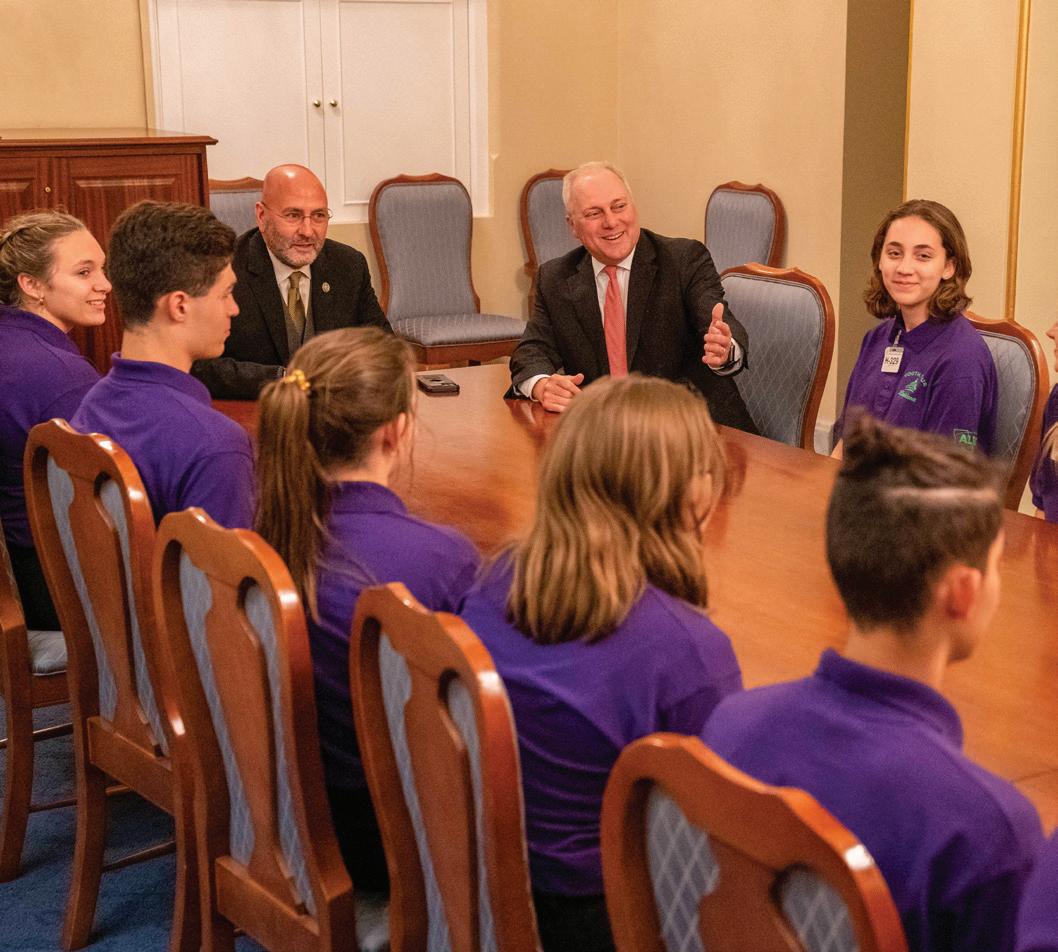








Other than seeing the sights in Washington, D.C., and learning from various leaders, Youth Tour students are quick to mention they enjoy the new friendships they form over the week. This friendmaking process isn’t just fun, however. It has lasting benefits as well.

“I genuinely learned a lot about making friends,” Lillie says. “I came into the Youth Tour with no one else from my school, but I was so blessed to meet many other people including the other participants from my co-op, and now we still try to see each other once or twice a year. I was able to use this experience of making friends when I decided to go out of state for college where I knew maybe three other people. The tour prepared me to be bold and put myself out there when meeting new people.”
Madelyn agrees with Lillie’s take on the specialness of Youth Tour friendships.
“My absolute favorite thing was getting to meet so many new people who share the same interests as me and making lifelong connections and friendships with many of them,” she says.
Beauregard Electric Cooperative Inc.

Samantha Baker, Audrey Bryant and Samantha Parks






Jeff Davis Electric Cooperative

Heath Hardesty and Khye Hornsby


South Louisiana Electric Cooperative Association
Madeleine Boudreaux and Presley Blanchard


Washington–St. Tammany Electric Cooperative
Lylah Crain and Holly Melton











Samantha found the diversity of experiences and perspectives among the participants especially interesting.
“One of the most significant takeaways from the tour was the importance of reaching out and forming connections with others,” Samantha says. “I realized that you can quickly form strong bonds with people if you’re willing to try, and everyone has more depth to them than initially meets the eye. I’m looking forward to applying this lesson in college, where I hope to be more outgoing and build meaningful relationships, rather than sticking to my usual reserved nature.”




Conley witnesses the friendships blooming and strengthening on each year’s tour.



“Even for those who have been to D.C. before with family or school, this trip is still incredibly special. It’s different,” she says. “Traveling with about 15 other delegates from across Louisiana, spending seven days together on a bus, learning about the cooperative business model, gaining valuable life skills and stepping outside their comfort zones, all of that creates something unique. Along the way, they build lifelong friendships and unforgettable memories. Then there’s Youth Day, where delegates join students from 44 other states to trade pins and connect with peers from all over the country. Whether it’s your first time in D.C. or not, this trip truly is a once-in-alifetime experience.”



The Youth Tour can even help set a new path for participants’ futures.
Samantha, who just began her freshman year at Northwestern State University’s Scholars’ College in Natchitoches, decided to pursue a degree in criminal justice.

“The Washington Youth Tour experience has also inspired me to explore study abroad programs, fueling my desire to engage with diverse cultures and perspectives globally,” Samantha says.






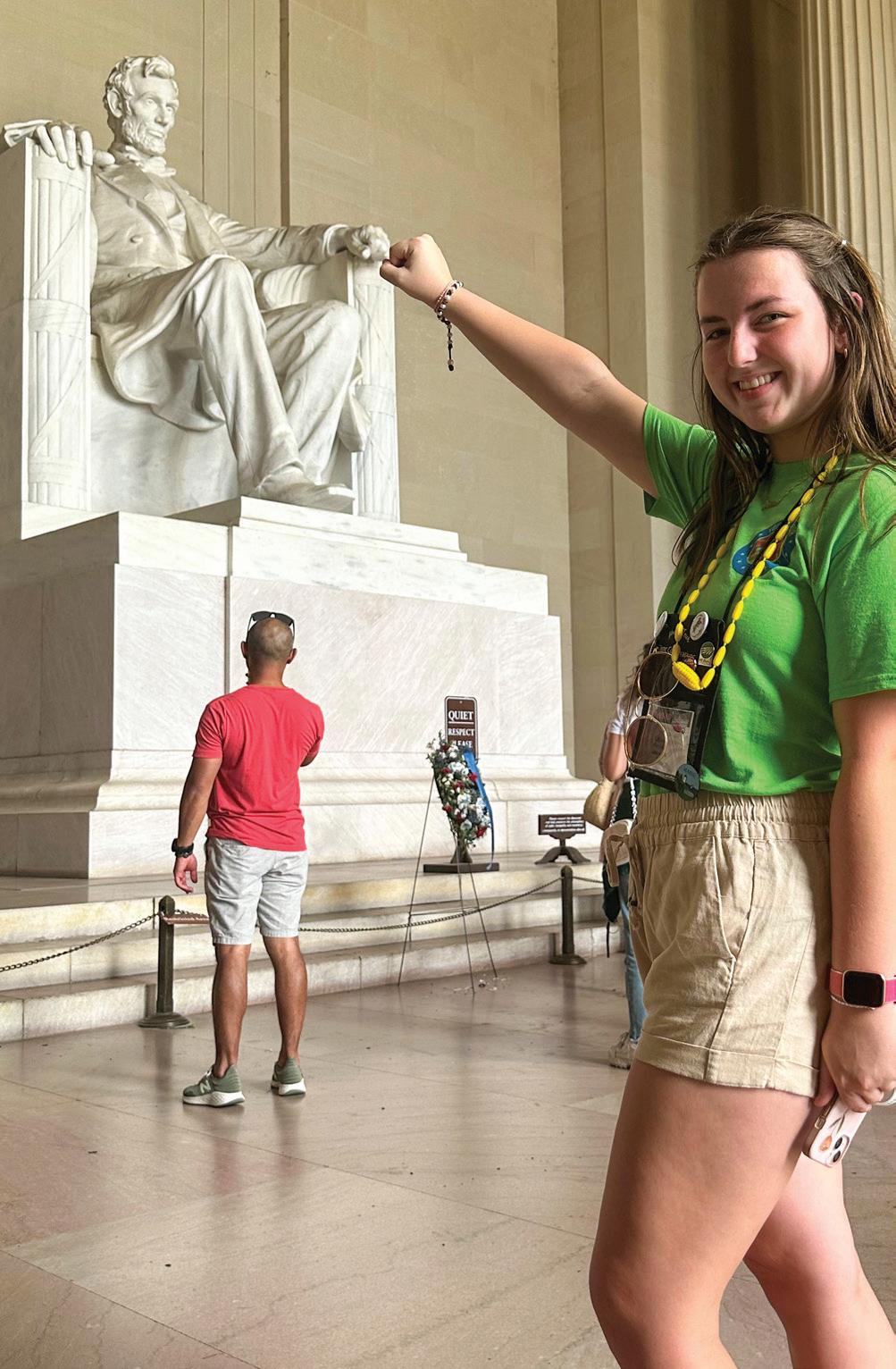


While the friendships, leadership workshops, deep dive into the history and current efforts of electric cooperatives, and aweinspiring sights make indelible impressions on these young Louisianans, sometimes it’s a simple, unexpected phrase that really hits home and becomes a guiding light as they progress through the rest of their formal education and then into lives as young adults.
Madelyn says one of the most impactful things she learned came from one of the keynote speakers, Mike Schlappi, a multiple Paralympic medalist and motivational speaker.






“During his speech, he told us, ‘Takers eat well, but givers sleep well,’” she says. “To this day, this excerpt still truly resonates with me. As a leader within my community, it is important to have a reminder that giving to others will take you much further in life than taking what others deserve.”














































































































Did you know the average daily cost of electricity is about $5? When you think about all the ways we use electricity every day, that’s a great value. A day’s worth of electricity powers heating/ cooling, electronics, lighting, major appliances and more.
Look at the everyday items below, then add a plus (+) sign next to the items you think cost more than daily electricity. For items you think cost less than daily electricity, add a minus (–) sign.




Cut your bills with these energy-saving
By Christina Sawyer
Fall in the South usually brings lower energy use—but not zero. That makes it a great time to tackle a few simple weekend projects that can boost efficiency and shrink your power bill for the long-haul.
Sustainability is a bonus, but the biggest impact may be on your wallet. So, roll up your sleeves and dive into these DIY energy-saving projects.
LED lights are far more energy-efficient than traditional bulbs and last significantly longer. Swapping out your old bulbs for LED equivalents is a simple and effective way to lower your energy consumption.
Spend some time this weekend replacing bulbs throughout your home, and watch your energy bills shrink over time.

Did you know air leaks around doors and windows can significantly increase your home’s heating and cooling loss? But fret not, because sealing these leaks is a quick

fix that yields tangible results.
Grab a caulking gun and some weatherstripping, and get to work sealing any gaps. This helps your HVAC system work less, prevents your hard-earned money from seeping out through cracks and keeps your home more comfortable year-round.
We’re all guilty of leaving electronics plugged in when they’re not in use. Even in standby mode, these devices still draw power. This phenomenon, known as standby power or phantom load, can account for up to 10% of your home’s energy use.
Spend some time this weekend unplugging unused devices or investing in smart power strips that automatically cut power to devices when they’re not in use.

Even as fall sets in, heating and cooling systems in our region stay busy keeping


homes comfortable. But like any piece of machinery, it requires regular maintenance to perform optimally.
Spend a weekend changing filters, cleaning vents and scheduling a professional tuneup. Not only will this improve your system’s efficiency, it will also extend its lifespan, saving money in the long run.
In today’s digital age, there’s a smart solution for just about everything— including energy management.
Consider investing in a smart thermostat that learns your habits and adjusts your home’s temperature accordingly. Pair this with smart plugs, lights and appliances, and you’ll have complete control over your home’s energy consumption at your fingertips.


Before diving headfirst into the world of smart home technology, it’s crucial to ensure your home’s electrical










system is up to the challenge. Here are a few steps you can take to prepare:
• Start by inspecting your home’s electrical panel. Determine its age, capacity and condition. If your panel is outdated or overloaded, it may struggle to accommodate the additional load from smart devices. Consult with a licensed electrician to assess whether an upgrade is necessary.
• Inspect the wiring throughout your home to ensure it’s in good condition. Look for signs of wear and tear, such as frayed insulation or loose connections.
If you have older wiring, such as knoband-tube or aluminum wiring, it may not be suitable for modern smart devices. In such cases, rewiring or retrofitting may be required for safe compatibility.


• If your home still has traditional outlets and switches, consider upgrading to smart-compatible versions. Smart outlets and switches offer added functionality and convenience, allowing you to control lights,
to


appliances and other devices remotely. Just be sure to follow manufacturer guidelines and consult with a professional if you’re unsure about installation.
By taking the time to assess and prepare your home’s electrical system, you can ensure a smooth and seamless transition to smart home technology. With the right infrastructure in place, you’ll be ready to embrace the convenience, efficiency and innovation smart devices have to offer.
When it comes to landscaping for energy efficiency, planting trees can make a world of difference. By planting trees, shrubs and vines strategically around your home, you can create natural barriers that provide shade in the summer and act as a windbreak in the winter.

Spend a weekend mapping out your landscaping plan, considering factors such as sun exposure, wind patterns and

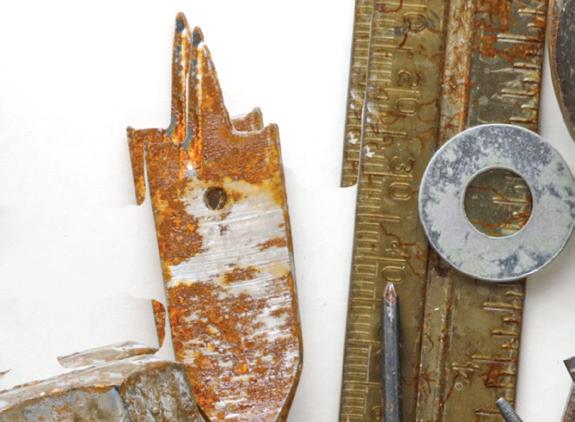



existing structures. With a little foresight and planning, you can create a green oasis that enhances your home’s energy efficiency and adds value and curb appeal. Remember to avoid planting trees directly under power lines, as this can lead to potential hazards and costly maintenance issues down the road. Before you start digging, call 811 to have underground utility lines marked. This simple step can prevent accidents and ensure a smooth and safe planting process. By implementing simple measures such as switching to LED lighting, installing programmable thermostats or sealing leaks, homeowners and renters can lower their energy consumption and save money. Armed with new knowledge, you can become a weekend warrior, save money and make a difference, one project at a time.
















By Drew Woolley









ages, cooperatives have learned a few helpful tricks to resonate with younger audiences. Hands-on activities, such as asking kids to look through their backpacks for electronic devices and calculating how much energy they use, can drive home just how much electricity they use in their daily lives. Meanwhile, avoiding technical terms like “energy efficiency” can help saving energy feel less daunting and more fun.

Everyone likes finding ways to save on their energy bill. But watching the thermostat like a hawk, turning off lights behind everyone in the house and sweating an investment in energy-efficient appliances isn’t much fun, especially when you’re trying to get the kids to play along. Fortunately, electric cooperatives have been working to make energy savings more approachable for many years.





AIGENERATED ILLUSTRATION
BY FREEPIK/BRANDON POMRENKE


Even so, some of the most effective ways to drive home the importance of energy conservation are the routine reminders members may have heard from their parents growing up. Luckily, there are still plenty of ways to teach your kids the importance of energy conservation while having fun as a family.


After decades of educating kids of all






Here are some fun ways to encourage energy efficiency and conservation at home: Cook a family-powered dinner. Have the whole family help cook dinner with one rule: No electricity is allowed. Avoid using major kitchen appliances like electric ovens, blenders, mixers or
microwaves to teach kids about common ways your family uses electricity during peak demand times. Top it all off with some no-bake treats.




Take turns on power patrol. Every child enjoys being in charge from time to time. Take turns letting everyone in your family be responsible for enforcing good energy habits around the house for a week. You can even set up a point system for every time they notice a light left on in an empty room, unplug unused electronics chargers or adjust the thermostat to a more efficient setting. Offer prizes and rewards to encourage them to be mindful of energy use every day.








Build an energy-efficient dream home. Encourage everyone to design their dream home with energy-saving features in mind. This is a great way to introduce ideas like solar panels, efficient appliances and sustainable building materials. Break out the crayons and art supplies to bring their homes to life, or use household crafts to build models.











Play energy-saving bingo. Make bingo cards with squares for energysaving actions like using natural light instead of lamps or ceiling lights, unplugging devices, turning off lights and cooling off the temperature by opening a window. Kids can cross out each square as they complete each task, and the first one to bingo gets a prize.








Have power-free fun. Designate one night a week as power-free time when everyone in the family turns off phones, computers and TVs together. Play a board game, spend time reading your favorite books or enjoy some outdoor activities technology-free. Save on your electric bill, teach the importance of reducing energy use during peak periods and get some valuable family time all at once.




Make an energy-saving scavenger hunt. Make up a list of energy-saving practices, such as updating light fixtures with LED bulbs, turning off lights in empty rooms and unplugging





unused devices. Challenge your kids to search the house and check off an example of each scavenger hunt item. You can celebrate with small prizes or treats for each energy-efficient discovery they make along the way.






Create energy-efficient art. Kids enjoy seeing their artwork displayed, so put those creative skills to work on energy-efficient reminders around the house. Spend arts and crafts time teaching your kids about some of the steps they can take to save energy around the house. Make fun signs to serve as daily reminders to close the fridge quickly, turn off lights and only change the thermostat as a last resort.






every time someone spots an unused device still plugged in. Set a goal and reward yourselves when everyone keeps phantom energy use down. No matter what you do to keep energy savings fun around the house, the most important part of instilling good habits is reliably reminding your family of the little steps they can take to be more efficient. Consistency is key.




Keep “phantom power” waste bottled up. Phantom energy—the electricity devices use even when they are turned off— can be a tricky concept for kids to understand. Illustrate it in a fun way by adding marbles to a glass bottle or jar






















